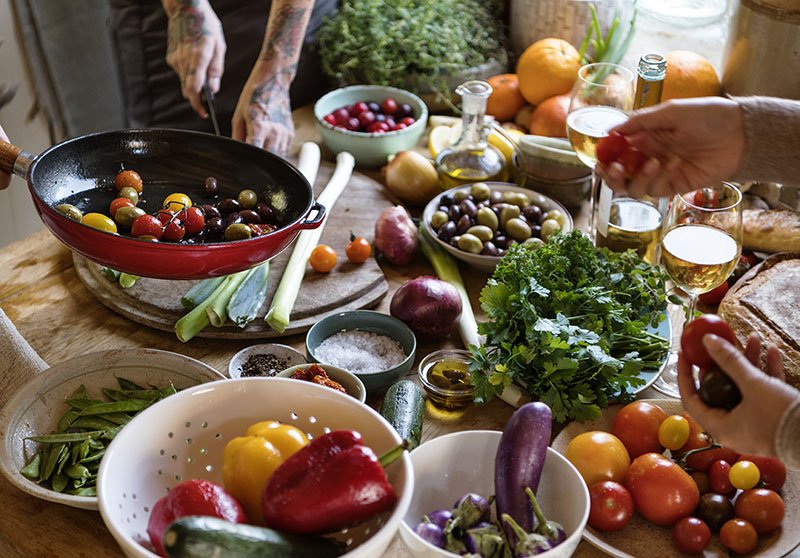The best diets for our health is something we all eventually realize is important if we want to live a vital life. Regardless of age, or whether male or female, the thing we all have in common is the need to live a vigorous life. When we are young, we are self-assured in our efforts to live a robust life because youth allows us to believe we are indestructible and unstoppable.
The Importance of What We Eat Becomes A Realization
However, as we age, our self assuredness wanes and we are more doubtful of our ability to continue to be a force of nature. This would probably explain why statistically men and women between the age of 18 and 34, visits the gym more than any other age group. It’s not just about getting physically fit. They question their appearance because they notice the connection between what they eat and how they look and feel.
As we age, there are factors we would otherwise not consider. Some considerations are, as stated above, our weight, our energy, the quality of our sleep. Certainly, the response our bodies have after the foods we eat and drink. While as teenagers, we didn’t care about such things and would eat and drink anything as long as we liked the taste. As adults, that’s a different matter.
Looking Back…
If we were to reflect on past diets in our late teenage years and our twenties, compared to the diet we follow now, we would undoubtedly confirm that our normal routine then and now are starkly different. Is it possible that it could be worse now than a decade or two ago? Sure, but chances are that’s not the case.
Why? Because we learn. We recognize the messages our bodies give us, and we change accordingly. If we continue to be in tune with our bodies as the decades go by, over time, we come to a few realizations. We realize that if we want to live with vitality, if we want to get through a day, or a week, without feeling tired and worn out, we need to pay attention to the foods we buy and what we eat.
Related: How To Influence What Your Grocery Store Sells.
Food Bliss
Let’s not think we all pay attention to our bodies and change accordingly. A lot of us notice the inferior response we have to certain foods and ignore it. Why? Because the idea of going without the foods we love is as unappealing as the taste of cardboard.
It’s undeniable that we all enjoy foods we don’t want to consider giving up. The ice cream, the steak, pizza, the food types are endless. But what if consuming certain foods is bad for your health? What if you have a condition such as celiac disease and consuming gluten is detrimental to your health? Do you consume those foods any way? The expected response would be no, but it’s amazing how many people know of their predisposition to gluten, yet continue to eat foods that contain this type of protein.
Our choices determine our health
As humans, we get to make choices. We can make good ones, or bad ones. This is the case in every aspect of our lives and certainly with our health. As adults, all of us know that there are benefits to following a healthy diet. When we choose such a course, we not only improve our health and nutrition, we protect ourselves from many chronic diseases such as heart disease, diabetes and cancer. When we make choices that are good for us, we promote health and vitality, the very thing we pursue.
Now the question remains, what are the better choices? Depending on who you ask, the answer can be broad. We have the high protein advocates, and at the opposite end of the spectrum, we have the vegan advocates. With the diet we follow, there are underlining factors that contribute to what we eat. One of the most obvious is our younger years. If we grew up on meat and potato as a diet staple, most likely that’s the diet we follow as adults.
Soon we want to know what are the best diets for health
For those of us who may wonder if certain diets are better to follow than others, the answer is a resounding yes. Keep reading as we share five diets that, if followed, can contribute to maintaining health and vitality throughout our lives.
A side note before sharing the best diets
Before delving into the best diets, let’s acknowledge that we are all different. The foods we eat are no exception to our distinction. In fact, according to this post published by the Washington Post in 2014, there is a technical name for our food diversity. It is called bio-individuality. It’s not uncommon that some people thrive on a raw food diet, while others don’t. There are those who feel more vital when they consume meat, and those who feel bloated after a meal that’s ninety percent meat. Our uniqueness matters, even when deciding what to eat. While the diets below are recommendations, they are not the only choice. As individuals, we are unique, even in our nutritional requirements.
The Mediterranean diet

This diet is one of the best diets to follow. It is the diet of those living in countries that border the Mediterranean sea. These regions include Greece, Italy and Spain. Their traditional way of eating emphasizes plant-based foods focusing on vegetables, whole grain, nuts, and fruits. Their main condiment is olive oil and they eat fish, red wine and dairy sparingly.
Named the best diet, or way of eating, that emphasizes good health for the past five years. The Mediterranean diet can reduce several health risks that are common in countries such as the United States.
How it works
We can call this way of eating a diet. In actuality, it isn’t. What this diet is, is an approach that is not as restrictive as some diets. The key to the Mediterranean diet is the inclusion of certain foods that are fresh, whole, and unprocessed. While this approach to eating in non-restrictive, those who follow it avoid foods high in saturated fats, red meats, and dairy.
Pros of Following a Mediterranean diet
- Lower risk of cardiovascular disease & stroke
- Prevent cognitive decline, including Alzheimer’s disease
- Reduce the risk of Parkinson’s disease
- Increase longevity
- Protect against diabetes
- Weight loss
- Easy to stick with
- Low in saturated fats
Cons of Following a Mediterranean diet
- The potential to consume too much alcohol
- The food expense can be exorbitant
- Because there are no general eating guideline guidance may be necessary, especially if preexisting conditions such as diabetes are already present
- Challenging to remove certain foods like sugar to conform to this way of eating
Summary
The Mediterranean diet is one of the best diets because it’s a way of eating based on countries bordering the Mediterranean sea. The foundation for this diet is plant-based, focusing on fruit, vegetables, whole grains and nuts. Popular because of its ability to reduce illnesses, yet flexible enough to follow.
The Dash Diet

If ever there is a diet specifically created for a purpose, the dash diet is it. This diet is one of the best diets for health and vitality because it can help billions of people worldwide with high blood pressure by reducing or eliminating it. Over the past four decades, people with high blood pressure have doubled. The problem isn’t so much that people with high blood pressure have massively grown; It’s the result of having high blood pressure that’s troubling. If unfortunate enough to develop this condition, it means that there is a higher risk of heart disease, stroke and kidney failure that is linked to the condition. The Dash diet combated high blood pressure, therefore reducing the risk of serious conditions as the ones above.
How it works
They created the Dash diet after researchers notice that high blood pressure was less common in those who follow a plant-based diet. It makes sense to them that this diet should focus more on fruits and vegetables, with less emphasis on meats. The diet allows lean proteins sources such as chicken, fish and beans. When following this diet, it’s important to exclude certain foods such as red meats, salt, added sugar, and certain fats.
The diet suggests a few servings of recommended foods, as outlined below. These foods include a limit to added sugars, sweets, to 5 or less serving per week. Here are other examples of serving sizes: 6-8 servings of grains or grain products (whole grains recommended), 4-5 servings vegetables, 4-5 fruits, 2-3 low fat dairy foods, 2 or fewer 3-ounce servings of meat, poultry, or fish, 2-3 servings of fats and oils, and 4-5 servings of nuts, seeds, or dry beans per week.
Pros of following the Dash Diet
- Backed by major health institutions
- Blood pressure reduction
- Reduce cancer risk
- May reduce weight
- Decrease heart disease risk
- Accessible
Cons of following the Dash Diet
- Very restrictive, because tracking foods is a requirement
- Hard to follow because of food restrictions
- Food choices are not comprehensive
Summary
This diet is one of the best diets because, although restrictive, the Dash diet can help to create a heart healthy eating lifestyle. While some say it’s easy to follow and others say it’s not, it is a diet that offers eating options that can help you live optimally.
Intermittent Fasting

If you’ve never heard of Intermittent Fasting (IF) and think it’s an alternative approach or a fad, think again. It’s existed for centuries. Used historically by the Greeks to cure certain illnesses, by ancient Romans to reduce their food intake, and by Chinese civilization for medicinal purposes. Today, religious groups still use it for fasting for spiritual reasons. In our society, we’ve learned that fasting offers benefits that are more appealing for those who are healthy today and want to stay that way for as long as possible.
How it works
Intermittent fasting involves abstaining from foods and certain drinks for intermittent periods. The timeframe for abstaining varies, but it is usually between 8 to 20 hours and for some it may involve avoiding food for days.
There are many descriptions of the methods used for intermittent fasting. Which ever window you choose, studies show that if we abstain from food and only eat within the typical 8 hour timeframe, we reduce our chance of obesity, diabetes, and inflammation in the body.
Methods
Fast for 16, 18, 20 hours. If you fast for 16 hours, you have an 8 hour eating window. If you fast for 18 hours, you have a 6 hour eating window. Fast for 20 hours and you have a 4 hour eating window. The most common is the 8 hour window.
Time lapse fasting isn’t the only method to consider. There is also the 24-hour or whole day fast, the alternate day fast, and quite a few others that take intermittent fasting to the extreme. Whichever method you choose, it’s important to realize this is not for everyone and it’s not a one size fit all approach. There are many ways to gain the benefits of fasting. The key is determining which works best for you.
Pros of following Intermittent Fasting
- Increase energy
- Unrestricted eating
- No calorie restrictions
- Easy to follow
- Boost longevity
- Promotes weight loss
- Mental clarity
- Lower blood pressure & cholesterol
- Increase longevity
Cons of following Intermittent Fasting
- Difficult to start
- Severe hunger
- May promote overeating
- Hard to stick with long-term
- May feel grumpy
- Interferes with social life
- Can trigger eating disorders
Summary
This diet is one of the best diets because the focus isn’t on what to eat, but on when to eat. As you cycle through periods of eating and not eating, our bodies’ metabolic health improves.
Vegan & Vegetarian Diet

Being a vegan means not having any animal products. A vegetarian enjoys dairy, but refrains from eating any animal products as well. If you’ve read this far, then you will notice the one thing the diets above have in common: a reduction of meat in the diet. With a vegan or vegetarian diet, it’s not reducing how much meat you eat, but removing it entirely from the diet.
Being a vegan or vegetarian has contrasts. Those differences are not what this post is about. However, both classifications share one characteristic. They both agree that all meats, contains high levels of saturated fats and cholesterol, which is associated with cardiovascular disease. Even more startling is the carcinogenic classification of meats. Processed meats are class 1, which means along with smoking and asbestos can cause cancer. All red meats are class 2, and probably cause cancer.
In reality, vegans and vegetarians eat healthily. After all, if you don’t eat meat, you are replacing those calories with fruits and vegetables. Again, this post is not about the vegans and vegetarian who eat unhealthily.
How it works
The premise of a vegan diet is fruits and vegetables, whole grains, plant-based protein, nuts and seeds. In addition, a vegan makes a choice to remove all animal by-product from their diet. For vegans, being a vegan is also a lifestyle choice. They are likely to choose not to use or purchase products that contain animal by-product.
A vegetarian doesn’t follow the lifestyle component of a vegan. However, they will follow the general food guideline of a vegan, but will consume animal byproducts. A vegetarian has several classifications.
- Lactovegetarian – will eat dairy products like milk, yogurt, butter, cheese.
- Ovo-Vegetarians – do not consume dairy, but choose to eat eggs.
- Lacto-Ovo-Vegetarian – choose to consume both dairy products and eggs.
Pros of following a vegan or vegetarian diet
- Consume a variety of fruits and vegetables
- Better weight management
- High fiber intake
- Lower risk of chronic diseases
- Environmentally sustainable
- Lower grocery cost
Cons of following a vegan or vegetarian diet
- Adapting can be difficult
- Not convenient
- Easy to become nutritionally deficient
- Difficulty to eat out
- May affect social life
Summary
Vegan and vegetarian diets are one of the best diets for health and vitality because the focus is to avoid foods that are high in saturated fats like meat. If you are a vegan, you choose to avoid all meats and their byproducts. A vegetarian will also avoid meat, but some will choose to enjoy dairy, eggs, or both. Historically, choosing to be a vegan or a vegetarian is a healthy choice, if followed correctly. Like most diets, it’s easy to not make the right food choices.
Learn more about the vegan diet & Learn more about the vegetarian diet








